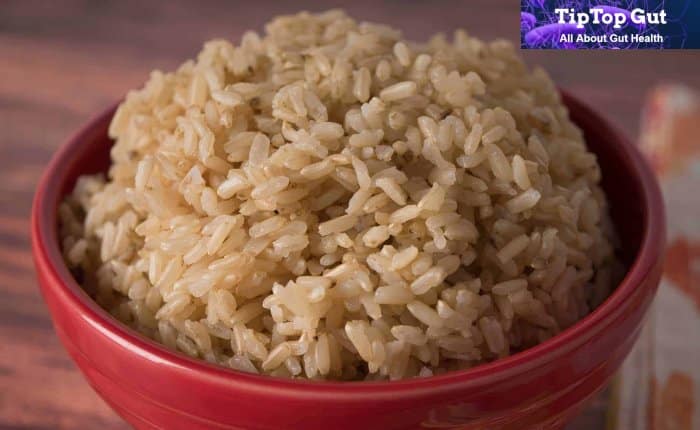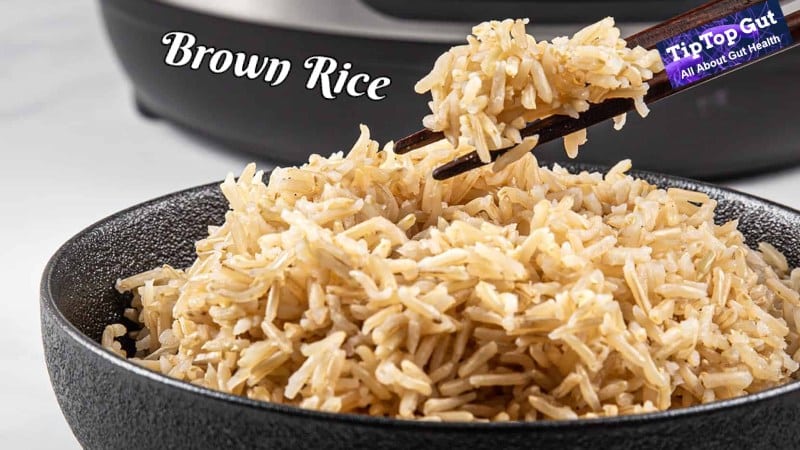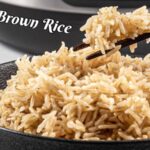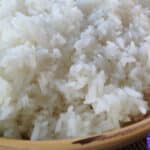The most widely consumed and adaptable grain in the world; rice is a staple meal. Although accepting rice is a simple decision, selecting white and brown rice is a more challenging challenge. Eating white rice involves consuming the grain after eliminating the husk, germ, and bran.
Gluten-free grains are good grains, including rice (brown or white), gluten-free oats, and buckwheat. Another excellent option is potatoes (white or sweet). They function as resistant starch for nourishing good microorganisms. When you consume brown rice, you consume the grain naturally.
So, is brown rice good for gut health? Let’s search the answer with the help of research.
Is Brown Rice Good For Gut Health?
For years, white rice has been a staple food in many cultures. It’s cheap, it’s filling, and it goes well with a variety of dishes.
However, recent studies have shown that white rice isn’t as healthy as we once thought. In fact, white rice can actually be detrimental to gut health.
So, what’s a health-conscious individual to do? The answer is simple: switch to brown rice because brown rice good for gut health. Here’s why brown rice is good for gut health.
According to a study, consuming brown rice is associated with increased probiotic bacteria, lactobacilli, and other beneficial bacteria.
Brown rice is ultimately healthier for you because of the processing. But what advantages strictly come with picking brown rice?
High levels of dietary fiber and other polysaccharides, including arabinoxylan and -glucan, are found in brown rice. The glycaemic index is decreased due to the fibers and polysaccharides’ ability to control intestinal glucose absorption.
Additionally, it serves as a growth substrate for these substances, promoting the development of Lactobacillus and Bifidobacterium, two helpful bacteria that can help prevent diabetes and obesity and modulate the composition of the gut’s microbiome.
In a recent study, it was shown that there was a substantial correlation between type 2 diabetes, obesity, and the makeup of the gut microbiota. Brown rice has been shown to significantly impact the microbial composition of the human intestine.
This provides more evidence that brown rice’s anti-obesity and anti-diabetic properties are related to the makeup and activity of the gut microbiota.
Brown rice is incredibly healthy, containing nutrients like fiber and magnesium that can protect your heart and may lower your risk of heart disease, as well as fiber that is good for your digestive system and can help keep your intestines regular and prevent constipation.
The Reasons Why Brown Rice Are Good for Gut Health?
Though it may be lesser known than its white counterpart, brown rice is actually a much healthier option. Packed with vitamins, minerals, and antioxidants, brown rice provides a host of health benefits. It’s also a great source of fiber and protein, making it perfect for people looking to improve their gut health.
Let’s take a closer look at some of the ways brown rice can benefit your gut health.
Brown Rice is Good for Digestion
One of the main reasons brown rice is good for gut health is because it’s packed with dietary fiber. Dietary fiber helps to keep our digestive system regular and can also help to reduce the risk of constipation and other gastrointestinal disorders.
Brown rice is a particularly good source of the soluble fiber beta-glucan, which has been shown to promote healthy bowel movements and improve gut motility.
Brown Rice Can Help Reduce Inflammation
Chronic inflammation is a major contributing factor to many gut disorders, such as Crohn’s disease and irritable bowel syndrome.
Luckily, brown rice contains high levels of the antioxidant gamma-tocotrienol, which has been shown to help reduce inflammation throughout the body.
In addition, brown rice is also a good source of magnesium, another nutrient that has anti-inflammatory effects.
Brown Rice Promotes Gut Healing
In addition to helping reduce inflammation, the gamma-tocotrienols present in brown rice can also help promote gut healing. These compounds help to protect the lining of the intestines, which can be beneficial for people suffering from inflammatory bowel diseases or who have had intestinal surgery.
Insoluble Fiber in Brown Rice
One reason brown rice is good for gut health is because it contains insoluble fiber. This type of fiber doesn’t dissolve in water andhelps add bulk to stool, which aids in the digestive process.
White rice, on the other hand, contains very little insoluble fiber. As a result, people who eat a lot of white rice are more likely to suffer from constipation.
Brown Rice Loaded with Nutrients
Brown rice is good for gut health because it’s also packed with vitamins and minerals. Vitamins and minerals are essential for maintaining a healthy digestive system.
Brown rice is especially rich in magnesium, which helps relieve constipation and aids in detoxification. White rice, on the other hand, is lacking in many vitamins and minerals.
Brown Rice Promotes Regularity
Brown rice is good for gut health because it helps promote regularity. Brown rice helps bulk up stools and keeps things moving through the intestines at a healthy pace. White rice, on the other hand, can actually lead to irregularity due to its lack of insoluble fiber.
Read More:
Biotics 8 Review: SCAM or A Legit Probiotic for Men?
How Are Brown Rice And White Rice Different?
A whole grain rice has three layers: a starchy center, a fibrous layer in the middle called the bran, and a fibrous layer on the outside called the germ (the endosperm).
Manufacturers remove the outer two layers of the original grain, leaving only the starchy interior, to create white rice, which is essentially a processed version of brown rice. This produces a more shelf-stable product with a milder flavor that pairs well with other components in some recipes.
The processing that white rice goes through loses a lot of the vitamins, minerals, and fiber that make rice healthy, so producers routinely enhance white rice to recover some of those nutrients. White rice is also softer, cooks faster, and frequently costs less.
How Healthy Is Brown Rice?
With only washing and packaging, brown rice is a minimally processed whole grain that retains all of its natural fiber, vitamins, and minerals, including:
- Selenium, which boosts immunity and guards against infections and cell damage.
- Magnesium promotes muscular function and supports bone growth, aiding in the blood clotting process when we are damaged.
- Folate, which is frequently advised for pregnant women but is healthy for everyone. Folate encourages cell division and aids in creating genetic material, among other things.
Brown rice is also high in dietary fiber, which helps prevent constipation, supports the growth of healthy bacteria in the stomach, lowers blood pressure, lowers cholesterol, and makes you feel fuller for longer.
What Is The Flavor Of Brown Rice?
I feel that when it comes to flavor, brown rice and whole wheat goods tend to have a bit of a bad rap, mainly because so many of us grew up on white bread and white rice products.
Overall, though, I find that people frequently prefer the flavor and texture of brown rice once they get beyond their first hesitant to try new things. Sometimes, you want your grain to be a bit bland to meld with the flavors in a recipe.

Health Benefits of Brown Rice
Let’s explore the advantages of brown rice for your health.
Nutrient-rich
Regarding nutrient content, brown rice slightly outperforms white rice because it has more fiber, antioxidants, vitamins, and minerals. However, these differences are insignificant.
Comparatively speaking, 100 grams (3.5 ounces) of cooked brown rice has 1.6 grams of fiber, while 100 grams (3.5 ounces) of white rice contain just 0.4 grams.
Improvements in blood sugar levels
Magnesium and fiber are abundant in brown rice, which assists regulate blood sugar levels.
Regular consumption of whole grains, such as brown rice, has been demonstrated to lower blood sugar levels and reduce the risk of type 2 diabetes.
On the other hand, white rice has a high glycemic index (GI), which assesses how rapidly a food raises your blood sugar and maybe why eating a lot of it has been associated with an increased risk of diabetes.
White rice raises blood sugar levels more quickly than brown rice, with a GI of about 89 compared to roughly 50 for brown rice, but both are pretty high in carbs, raising your blood sugar levels.
Lowers the risk of heart disease
According to studies, consuming brown rice may help lower a number of heart disease risk factors.
Those who consumed whole grains, including brown rice, had a 16–21% lower risk of heart disease than those who consumed the fewest whole grains, according to a review of 45 research.
Even while brown rice has been related to an increase in HDL (“good”) cholesterol, whole grains like brown rice may also lower total and LDL (“bad”) cholesterol. However, these results are different across different groups.
Rich in antioxidants
Numerous potent antioxidants are present in the bran of brown rice, which can help reduce inflammation in the body and neutralize damaging free radicals.
Studies have shown that whole grains like brown rice, which are high in antioxidants, may help prevent chronic diseases, including heart disease, cancer, and type 2 diabetes.
Helps to reduce body weight
Alternating between brown and white rice can help people lose weight, lower their BMI, and shrink their hip and waist circumferences.
Researchers discovered that the more whole grains people consumed, the lower their body weight in a study involving 29,683 adults and 15,280 children.
Furthermore, brown rice decreased body weight and waist size compared to white rice in a randomized controlled experiment including 40 overweight and obese women.
Provide 88% of your manganese requirements
Manganese is a mineral that isn’t often discussed, but your body needs it to function correctly. You can find manganese in foods like legumes, leafy greens, nuts, and whole grains like brown rice.
Manganese is essential for many bodily functions, including bone development, wound healing, muscle contraction metabolism, nerve function, and blood sugar regulation.
One cup of brown rice contains 88% of the daily recommended amount of manganese.
Strengthens the bones
Brown rice is a good source of calcium, magnesium, and manganese; a manganese deficiency has been linked to demineralization and decreased bone formation.
As a result, it promotes general bone health, promotes bone healing, controls muscle activity, and is essential for preventing osteoporosis and arthritis.
Defends nerve cells
Because of its high fiber content, which lowers cholesterol levels and the risk of neurological diseases like Parkinson’s and Alzheimer’s, brown rice lowers the risk of these conditions.
Antioxidants also shield cells from damage by free radicals, which shields them against inflammatory and degenerative diseases.
Read More:
Best Probiotic for Gut Health and Bloating: According to Health Expert
Brown Rice’s Drawbacks
There aren’t many disadvantages to utilizing brown rice aside from the advantages.
The antinutrients in brown rice
Brown rice includes phytic acid, also known as phytate, an antinutrient that makes it more difficult to digest and may decrease your body’s capacity to absorb some nutrients.
Soaking rice before cooking can help maintain some of its nutritional value. However, phytic acid may have some health benefits and decrease your body’s capacity to absorb iron and zinc from your diet.
However, this is exceedingly rare for persons who eat a diversified diet. Long-term consumption of phytic acid with most meals may contribute to mineral shortages.
Arsenic in brown rice
Significant quantities of arsenic have been found in rice and rice-based goods, and brown rice tends to contain more arsenic than white rice. Arsenic is a dangerous heavy metal that occurs naturally in the environment but has been rising in some places due to pollution.
Your risk of developing chronic illnesses, including cancer, heart disease, and type 2 diabetes, may rise if you consume arsenic over a long period.
Brown Rice Varieties
You could come across a few distinct varieties of brown rice, such as:
- Short-grain brown rice is sticky and excellent for risotto and rice pudding.
- When cooked, medium-grain brown rice is delicate and moist, making it ideal for adding to salads, soups, and side dishes.
- Long grain brown rice, a common variety that is chewy, nutty, and typically served as a side dish, in stir-fries, or dishes like fried rice or pilaf.
- Light brown rice, made by removing half of the bran from conventional brown rice, is light brown, faintly nutty, and requires a significantly shorter cooking time than regular long-grain brown rice.
- Brown basmati rice, the same as white basmati rice but hasn’t undergone as much milling, and processing, gets its name from the Hindi word for “queen of smells,” basmati.
- Try brown arborio rice, a short-grain Italian rice that retains all its nutrients and is available in “brown” form; use it in rice puddings, paellas, and risottos.
- Coconut brown rice: For an extra creamy and delectable flavor, prepare your brown rice with coconut milk.
Concluding Now! Is Brown Rice Good for Gut Health?
Whether you’re looking to improve your digestion, reduce inflammation, or promote gut healing, adding brown rice to your diet is a great way to do it.
Brown rice is packed with dietary fiber, antioxidants, and other nutrients that can provide major benefits for your gut health.
So next time you’re at the grocery store, be sure to pick up some brown rice instead of white! Your gut will thank you for it.
FAQs about Brown Rice and Gut Health
Is brown rice a source of fat?
No, you shouldn’t be concerned about fat when eating brown rice because 100g of uncooked simple, cooked brown rice only has roughly 1.6g of fat, and that fat is from healthy plant sources.
For how long brown rice can be kept in the refrigerator?
Cooked brown rice can be stored in the freezer for up to 6 months, or it can be kept in the refrigerator for about 4 days if it is tightly covered in a shallow container.
Does brown rice contain no gluten?
Is Brown Rice Gluten FREE?
Like most forms of rice, brown rice is naturally gluten-free. Still, you should always check the packaging of your rice to see if it has been processed in a facility that also handles gluten or if it includes additional gluten-containing ingredients.
Read More:
Best Cooking Oil For Gut Health: 7 Healthy Oils and 3 Unhealthy Oils for Digestion
Are Pickles Good For Gut Health? Amazing Facts about Pickles & Gut Health
Stevia and Gut Health: 5 Strange Facts How Stevia Affects Gut Health?
Is white Rice Good for Gut Health? Surprising Facts Unveiled 2022
Is Popcorn Good For Gut Health? Amazing Facts Revealed 2022
Best Mushroom for Gut Health: What Science Recommends?
Sources and References
At TipTop Gut, we rely on peer-reviewed studies, academic research institutions, and medical associations. We avoid using tertiary references.
- FoodData Central
-
Mohan V, Spiegelman D, Sudha V, Gayathri R, Hong B, Praseena K, Anjana RM, Wedick NM, Arumugam K, Malik V, Ramachandran S, Bai MR, Henry JK, Hu FB, Willett W, Krishnaswamy K. Effect of brown rice, white rice, and brown rice with legumes on blood glucose and insulin responses in overweight Asian Indians: a randomized controlled trial. Diabetes Technol Ther. 2014 May;16(5):317-25. doi: 10.1089/dia.2013.0259. Epub 2014 Jan 21. PMID: 24447043; PMCID: PMC3996977.
-
Hu Y, Ding M, Sampson L, Willett WC, Manson JE, Wang M, Rosner B, Hu FB, Sun Q. Intake of whole grain foods and risk of type 2 diabetes: results from three prospective cohort studies. BMJ. 2020 Jul 8;370:m2206. doi: 10.1136/bmj.m2206. PMID: 32641435; PMCID: PMC7341349.
-
Atkinson FS, Brand-Miller JC, Foster-Powell K, Buyken AE, Goletzke J. International tables of glycemic index and glycemic load values 2021: a systematic review. Am J Clin Nutr. 2021 Nov 8;114(5):1625-1632. doi: 10.1093/ajcn/nqab233. PMID: 34258626.
-
Kazemzadeh M, Safavi SM, Nematollahi S, Nourieh Z. Effect of Brown Rice Consumption on Inflammatory Marker and Cardiovascular Risk Factors among Overweight and Obese Non-menopausal Female Adults. Int J Prev Med. 2014 Apr;5(4):478-88. PMID: 24829736; PMCID: PMC4018597.
-
Whole grain consumption and risk of cardiovascular disease, cancer, and all cause and cause specific mortality: systematic review and dose-response meta-analysis of prospective studies doi:10.1136/bmj.i2716
-
Min B, McClung AM, Chen MH. Phytochemicals and antioxidant capacities in rice brans of different color. J Food Sci. 2011 Jan-Feb;76(1):C117-26. doi: 10.1111/j.1750-3841.2010.01929.x. Epub 2010 Dec 1. PMID: 21535639.
- Albertson, A.M., Reicks, M., Joshi, N. et al. Whole grain consumption trends and associations with body weight measures in the United States: results from the cross sectional National Health and Nutrition Examination Survey 2001–2012. Nutr J 15, 8 (2015). https://doi.org/10.1186/s12937-016-0126-4

















